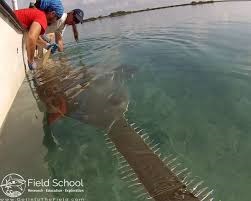
The overarching goal of this line of research is to answer critical ecological questions necessary to aid recovery efforts for one of the world’s most endangered fishes, the small tooth sawfish. The work will be conducted in the only two countries with viable populations of this species, the Bahamas and the U.S., and will be concentrating in two large national parks that could prove crucial to survival of the species. In 2010, we began a pilot study to determine the distribution of sawfish in the Bahamas, to use satellite telemetry to track their long-term movements, and to determine if the Bahamas supported a reproducing sawfish population. Our long-term goal has been to use telemetry along with population genetics to determine if sawfishes in the U.S. and the Bahamas represent a single mixing population or multiple isolated population segments. The goals of this fellowship will be to take this research the next steps and 1) discern the population structure of sawfish from the Great Bahama Bank (e.g. Andros and Bimini) and the Little Bahama Bank (Abaco) in the Bahamas relative to those in the U.S., 2) compare sawfish and shark relative abundances and community dynamics between Andros West Side National Park (an extremely remote and unfished area with almost no anthropogenic influence) and Everglades National Park (a large protected area with heavy fishing pressure and anthropogenic influence), and 3) estimate and contrast the carrying capacity of sawfish in the two parks in order to develop benchmarks for recovery. In addition to being the focus of three peer-reviewed manuscripts, the results will be incorporated into sawfish recovery plans in the Bahamas and the U.S. and may provide guidance to efforts to recover endangered sawfishes and guitarfishes in other part of the world.
This project will provide the postdoctoral scholar experience using and developing a variety of tools to study the applied ecology of fishes, including acoustic and satellite telemetry techniques, stable isotope and food web analyses, and community structure analyses, as well as stock assessment and extinction risk analyses.

